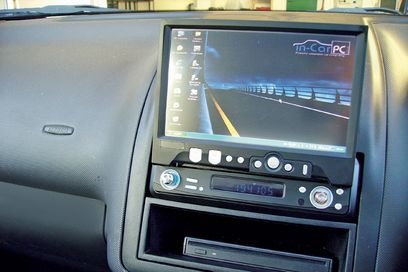ECU Components
The processor is packaged in a module with hundreds of other components on a multi-layer circuit board. Some of the other components in the ECU that support the processor are:
Analog-to-digital converters – These devices read the outputs of some of the sensors in the car, such as the oxygen sensor. The output of an oxygen sensor is an analog voltage, usually between 0 and 1.1 volts (V). The processor only understands digital numbers, so the analog-to-digital converter changes this voltage into a 10-bit digital number.
High-level digital outputs – On many modern cars, the ECU fires the spark plugs, opens and closes the fuel injectors and turns the cooling fan on and off. All of these tasks require digital outputs. A digital output is either on or off — there is no in-between. For instance, an output for controlling the cooling fan might provide 12 V and 0.5 amps to the fan relay when it is on, and 0 V when it is off. The digital output itself is like a relay. The tiny amount of power that the processor can output energizes the transistor in the digital output, allowing it to supply a much larger amount of power to the cooling fan relay, which in turn provides a still larger amount of power to the cooling fan.
Digital-to-analog converters – Sometimes the ECU has to provide an analog voltage output to drive some engine components. Since the processor on the ECU is a digital device, it needs a component that can convert the digital number into an analog voltage.
Signal conditioners – Sometimes the inputs or outputs need to be adjusted before they are read. For instance, the analog-to-digital converter that reads the voltage from the oxygen sensor might be set up to read a 0- to 5-V signal, but the oxygen sensor outputs a 0- to 1.1-V signal. A signal conditioner is a circuit that adjusts the level of the signals coming in or out. For instance, if we applied a signal conditioner that multiplied the voltage coming from the oxygen sensor by 4, we’d get a 0- to 4.4-V signal, which would allow the analog-to-digital converter to read the voltage more accurately (see How Analog and Digital Recording Works for more details).
Communication chips – These chips implement the various communications standards that are used on cars. There are several standards used, but the one that is starting to dominate in-car communications is called CAN (controller-area networking). This communication standard allows for communication speeds of up to 500 kilobits per second (Kbps). That’s a lot faster than older standards. This speed is becoming necessary because some modules communicate data onto the bus hundreds of times per second. The CAN bus communicates using two wires.

How Car Computers Work: ECU Components
by
Tags:

Leave a Reply